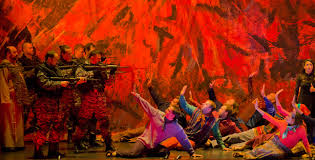London Coliseum, 4 March 2015
Purcell did not complete The Indian Queen and its history is complex with no really satisfactory version emerging. Add to this that it includes a considerable amount of dance and spoken text and the challenge facing any director might seem insurmountable. Peter Sellars takes a radical approach, moving away from any archaeological or musicological concept to make the work speak more directly to an audience bombarded on a daily basis with news of massacres and racism. He adds in other music by Purcell and text by a range of writers both 18th century and modern.
Individual moments work very well. The four dancers, with choreography by Christopher Williams, are a delight, their movements always apt, engaging and joyous, even if at times incomprehensible.
The solo singers are emotionally convincing, with some very beautiful arias. Lucy Crowe’s O Solitude and Anthony Roth Costanzo’s Music for a while are stunning in their impact. Choral singing, together with the signing which is a familiar feature of most Peter Sellars’ productions, is bright and clear even when they are lying flat on their backs. The pit is raised so that the small baroque ensemble is in full view and carries with unexpected impact. Under Laurence Cummings the musical sections are a delight throughout, with fine playing from the three theorbos and a goodly range of percussion.
With all these elements working so well, why did the evening ultimately fail? Put simply, the individual parts, no matter how good, did not add up into a whole. Whereas a through composed opera maintains its dramatic intensity, and even the narrative line of a singspiel does not let the tension drop, here the changes in atmosphere were simply too abrupt. The evening opens with the sounds of the jungle, electronically amplified through the theatre’s speaker system. We jump cut to the orchestra and then, as quickly, back to the jungle. Rather than have the Indian Queen, warmly sung by Julia Bullock, speak for herself, an actress, Maritxell Carrero comes on to address the audience out of character and fully amplified. The constant change of oral impact is disconcerting and ultimately alienating. This is also true of the design panels which float in and out by Gronk. Rather than, as suggested, providing another world, they remain uncompromisingly flat and often irrelevant to any action taking place in front of them. They are paintings not stage sets.
Peter Sellars has done a great deal of good for ENO in the time he has been with them and nobody could doubt the technical and musical finesse of this production. It was just a pity it failed to move us in the way intended.

